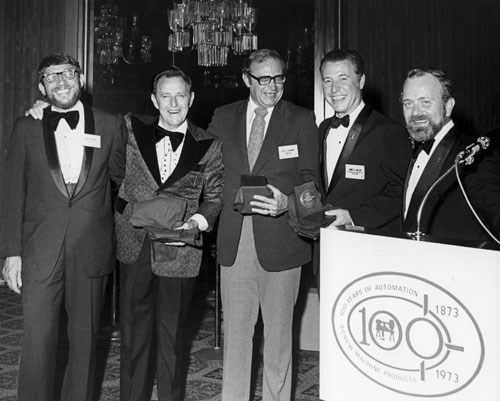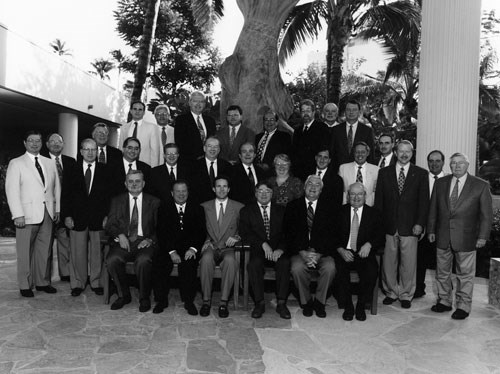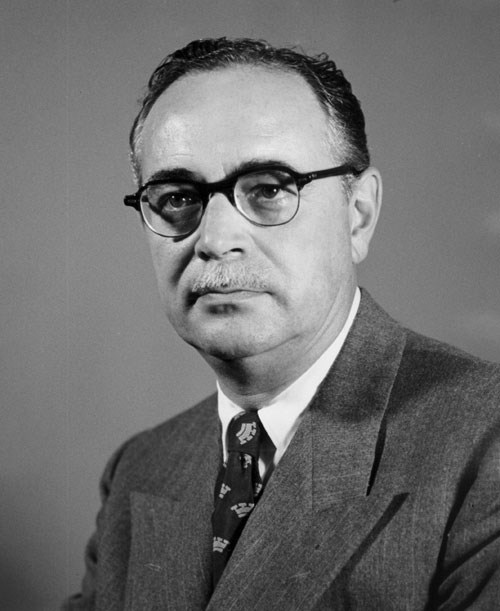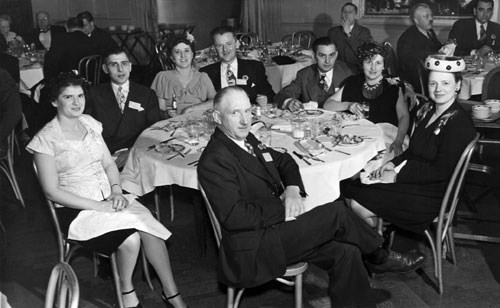The Evolution Of Your Trade Association:
This year, the Precision Machined Products Association is celebrating its 75th anniversary. From its humble beginnings in 1933, to becoming the industry leader in technical support and management information, the association has always focused on serving the needs of its members while supporting the broader interests of the precision machined products industry.
This year, the Precision Machined Products Association is celebrating its 75th anniversary. From its humble beginnings in 1933, to becoming the industry leader in technical support and management information, the association has always focused on serving the needs of its members while supporting the broader interests of the precision machined products industry.
On this momentous occasion, the PMPA would like to take a moment to briefly look back at the individuals, companies and events that helped shape the association throughout its 75-year history. Regrettably, not all who have given their time and talents will be recognized, since so many have contributed to the success of the association. However, the hope is that this brief overview of the association’s history will bring back fond memories and help us realize the efforts that have gone into building and sustaining the PMPA.
Featured Content
The Early Years–1920s
1923
Ten years before the formation of the National Screw Machine Products Association (now known as PMPA), the planning began to form a national trade association. In the summer of 1923, Earl E. Norman of Automatic Screw Machine Products Company, Chicago, was the first to conceive of the idea of a national organization of screw machine products manufacturers.
Mr. Norman and six of his Chicago competitors—Claude A. Knuepfer, General Engineering Works; John McDonough, Sherman-Klove Co.; Frank A. Smith, Economy Machine Products Co.; Russell G. Smith, F. H. Smith Mfg. Co.; Bert E. Wallace, Machinery Products Corp.; and Walter Ware, Ware Brothers—laid the foundation of the Screw Machine Products Association during a series of
luncheon meetings.
1924
In February 1924, the second meeting of this industry group was held at the University Club of Chicago. Shop owners from companies between St. Louis and Buffalo also attended. At this meeting, the group drafted the association’s first constitution and bylaws and elected Hugo Lundberg of Michigan Screw Company, Lansing, Michigan, as president of the Screw Machine Products Association. During the meeting, approximately 20 companies pledged to join the newly formed "Screw Machine Products Association."
Making It Official–1930s
1933
In 1930, under the National Recovery Act (NRA), trade association price-fixing and labor rate minimums became legal for a short period of time. With this strong impetus, the National Screw Machine Products Association (NSMPA) came into being at the association’s first official meeting at the Union League Club in Chicago on May 26, 1933.On August 16, David Bell of The David Bell Co., Buffalo, became the first president of the national trade association.
The association’s headquarters moved from Chicago to New York.
Formal districts were created in Buffalo, Rochester, Boston, Providence, Worcester, Philadelphia, Cleveland, Indianapolis, Detroit and Milwaukee. The districts were formed then to help facilitate local meetings of NSMPA’s growing membership.
1935
Following the Supreme Court’s decision declaring the NRA unconstitutional, an NSMPA national meeting was held in Detroit on June 19, 1935. It was agreed that the cooperative work of the association’s members would continue to support the industry during such challenging times.
The War Effort–1940s
1941
The association began in 1941 with 48 members. It held 51 district meetings, attended by 135 different companies for a cumulative attendance of almost 1,000.By the beginning of World War II, more than 75 companies were members of NSMPA. At the close of the war, more than 220 com-panies joined the ranks of the
association to support the industry.
Growth continued during this period as the association helped meet wartime needs. The association sent a special consultant to be part of the War Production Board’s Screw Machine Branch. The association was able to help negotiate matters ranging from manpower, material controls, production costs and other contractual elements during wartime production.
1949
Due in large part to the post-war recession, the association was forced to combine its operations with an association representing the stamping industry for a period of 6 years. This arrangement allowed NSMPA to save and plan for a new home, which opened in Cleveland in February 1952.
Industry On The Rise–1950s
1950
During the 1950s, the industry entered a period of transition—from a wartime market to growing civilian consumer markets. Also, a second generation of owners began taking over the management duties of their family-owned companies.With an understanding of the changing roles of leadership within its member companies, the association strengthened its programs and services to meet the new set of expectations of its members. Political action, legislative and regulatory issues were given more attention to help fend off the
government’s ever-increasing role in small business and the free enterprise system.
1952
The association opened its new headquarters in the Shaker Square section of Cleveland, Ohio, where it remained until 1979.The Birth Of The Tech Conference"–1960s
1962
The association held its inaugural National Technical Conference in 1962 at the Cleveland Sheraton Hotel in Cleveland, Ohio. Today, the Tech Conference is PMPA’s most popular national event, attracting more than 400 attendees annually.
Getting Political–1970s
1973
The 40th anniversary of the association, as well as the 100th anniversary of the industry, were celebrated at the annual meeting in Hartford, Connecticut.1974
The Alliance of Metalworking Industries (AMI) was founded by Asa Bonner Sr., A.T. & G. Company Inc., Farmington Hills, Michigan, and Robert Knuepfer, DuPage Machine Products, Bloomingdale, Illinois. This coalition banded together five similar trade associations with common problems to attain the leverage necessary to be heard in Washington, D.C.
1975
The first Management Update was held at the Marriott Inn, Cleveland, Ohio. It was the first in the series of annual management conferences designed to keep owners and managers abreast of the changes in regulatory issues, management philosophy, human resources and business trends.
1979
The Political Action Committee (PAC) was formed to strengthen the association’s lobbying efforts, through the support of U.S. congressmen and senators who back legislation favorable to the industry.The association relocated to its new, larger headquarters in the Cleveland suburb of Brecksville.
Managing Change – 1980s
1980
Several metalworking groups, including NSMPA, formed the "Task Force on the Skilled Trades Shortage" to encourage young people to enter the metalworking trades.The association conducted a series of "Estimating Clinics" aimed at helping member companies improve their productivity and profitability.
1982
Members overwhelmingly approved expanding the association’s scope to include all manufacturers of turned parts, including parts made on NC, CNC and rotary transfer machines.1983 The 50th anniversary celebration was held at the Opryland Hotel in Nashville, Tennessee.
The "Consuming Industries Market Analysis" was released by the association. It was the first attempt at defining the true market for turned parts.
"Statistical Quality Control" seminars were held in Chicago and Cleveland. They were followed by additional regional programs in 1984 and 1985.\
1986
The association expanded its programming with its first Computer Software Expo and marketing seminars. Also, the District Evaluation Committee established "cluster meetings" outside of the defined district meeting sites.
1987
The first "Suppliers Night" tool show was held in the Naugatuck Valley District. This biennial show continues to be a popular event, with strong attendance, as well as support from the technical membership.1989
The "Troubleshooting Machining Problems" video series was first released to the membership.The Digital Age--1990s
1992
The Industrial Relations Committee published the widely used "Job Description Manual" in printed form and—the first for the association—on computer diskette.1995
With changes in machining technology and the industry’s move toward processes not traditionally associated with automatic screw machines, the decision was made to change the name of the association. After careful consideration, the name proposed and accepted by a majority vote of the membership was the "Precision Machined Products Association" (PMPA).The association joins the World Wide Web with the unveiling of its ShopTalk Web site at the October 1995 annual meeting in Tucson, Arizona.
The first Association Strategic Plan, focusing on issues of critical importance to the membership, is approved by the Board of Trustees.
1996
PMPA announces its "members-only" ShopTalk Forums, available from the association’s Web page with user name and password. The ShopTalk Forums consisted of 11 different discussion groups and covered everything from politics to family business issues.1997
PMPA member volunteers complete two in-depth Screw Machining Skill Standards, which were formally approved by the board of the National Institute for Metalworking Skills (NIMS). Other metalworking skills standards were developed and revised during this period. Today, these standards serve as the basis for the NIMS certification program. 1998
PMPA eliminates ShopTalk Forums and replaces them with e-mail Listserve technology. Participation in PMPA discussion groups increases dramatically using this new format.Members of the PMPA celebrate the association’s 65th anniversary and the industry’s 125th anniversary during the annual meeting in Point Clear, Alabama.
1999
Based on a generous donation from a PMPA member, the association develops the PMPA Education Foundation. The foundation is formally approved by the board to provide financial support for industry training initiatives.2000
The PMPA Education Foundation receives a favorable ruling from the IRS as a 501 C (3) charitable organization.
2001
PMPA and Gardner Publications release the first issue of Production Machining in January. The publication is intended to serve the needs of precision machined products manufacturers.The PMPA holds the inaugural Precision Machining Technology Show (PMTS) in conjunction with the National Technical Conference in Columbus, Ohio. This focused industry show brings together manufacturers and suppliers from across North America.
2002
PMPA improves its member’s Web experience with district and chapter Listserves to enhance networking at the local level. During the same period, the association adds personalization features to the Web site, giving users better functionality.2003
PMPA leads a study mission to China to learn more about this emerging nation and its manufacturing capabilities.The association conducts its second PMTS show in Columbus.The show continues to grow in suppliers and attendees, attracting a diverse pool of participants from North America, Europe and Asia.
PMPA unveils "Marketplace," its searchable online database of member companies. Visitors to the PMPA Web site frequently use the feature (now known as "Find A Supplier") to locate suppliers. This Web page continues to be one of the most visited sections of the PMPA Web site.
2004
The association eliminates its printed newsletter and replaces it with an online version called "PMPA Weekly Reports." Weekly Reports are delivered free, via e-mail, to all PMPA member subscribers.PMPA develops a bi-monthly "Raw Materials Impacts Report," which tracks material costs and surcharges. It also provides analysis and reference material to assist precision machined products manufacturers and their customers in understanding the factors impacting the cost of raw materials. This report can be downloaded at no charge from the PMPA home page: www.pmpa.org.
The association releases its first "Business Intelligence Report" providing members with in-depth information on fuel cell technology. Additional "Business Intelligence Reports" covering lean manufacturing and European Environmental Directives and Regulations have since been released to the membership.
PMPA’s membership approves sweeping changes to the bylaws, adopting a new Code of Regulations and Membership Guidelines.
2005
PMPA enters into an agreement with Dr. Ken Mayland, president of ClearView Economics LLC, to provide monthly and quarterly economic data and analysis on major economic indicators and markets.The board approves a trial membership campaign, which results in 53 new members. This 1-year trial membership is still available to contract manufacturers (known as "Active Members") at the cost of $600.
PMTS 2005, the third installation of this focused industry show, exceeds all financial and attendance goals set by the association.
2007
PMPA unveils its new Web site design with greater functionality and personalization. New search capabilities and archiving improve the user’s Web site experience.PMPA installs a new online membership database to streamline operations and e-commerce
capabilities.
PMTS 2007 draws its largest attendance in the history of the Precision Machining Technology Show.
The association’s members-only "Nominal Steel Grade Translator" converts selected Chinese, Japanese and German grades into their U.S. equivalents (based on chemistry).
2008
The association releases a white paper providing members with a "Disaster Recovery Plan Procedure." The procedure assists PMPA companies facing unplanned disasters, such as tornadoes, fires, flooding, and so on. It provides the means to keep the supply of critical machined products flowing during an emergency.











